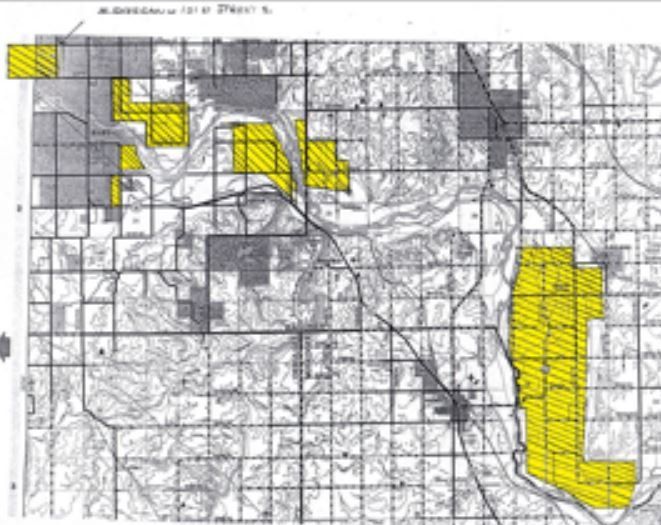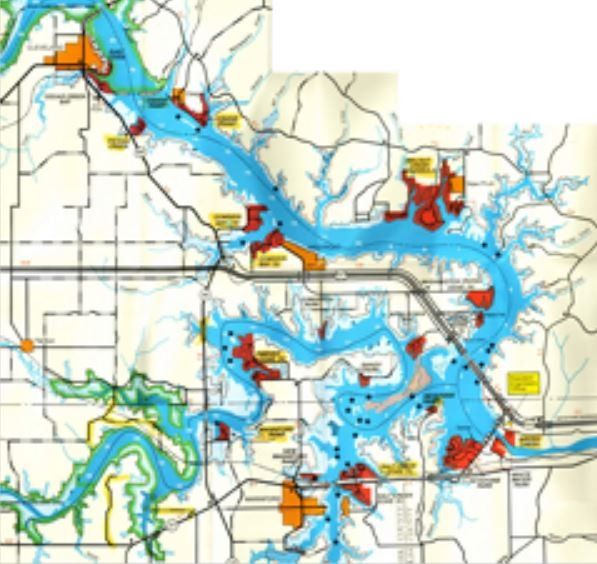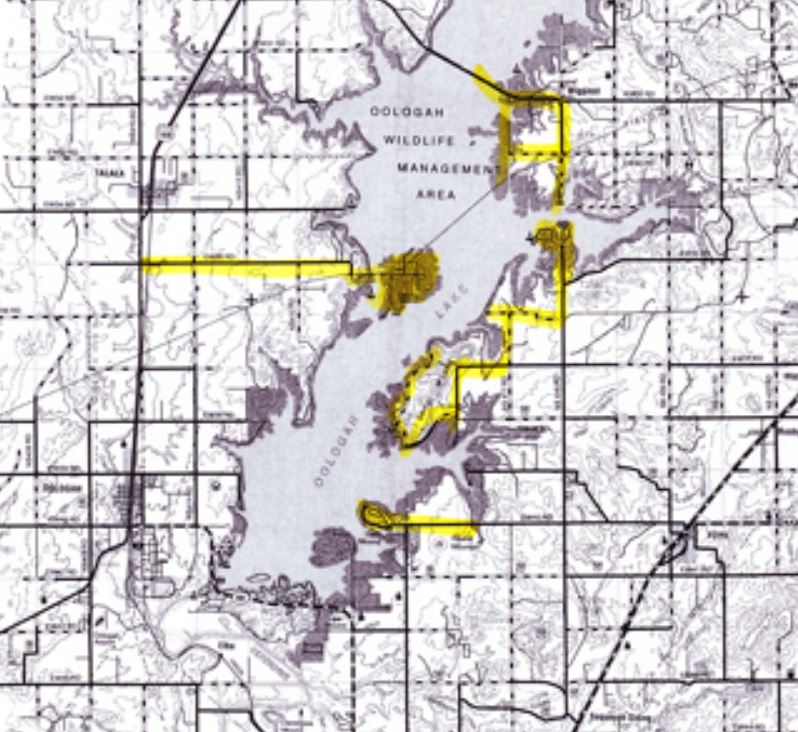
NE Okla Shorebirds
Shorebirds In Northeastern Oklahoma by Jim Arterburn
Jim Arterburn presented programs to Tulsa Audubon on Oct. 17, 2006 and on Jan. 18, 2011 on the shorebirds of northeastern Oklahoma, and Jim has graciously shared his presentation and other notes for those not able to attend the meeting. All of the documents have been updated in January, 2011.
Click here to visit Jim's website
to view his shorebird photo galleries (and other great photography!)
Shorebird Habitat Around Tulsa & NE Oklahoma
• Sod Farms
• Spring - Especially good during periods of thunderstorms and after heavy overnight rains
• Prime time is late April through late May
• Best time is early morning before birds move north & late afternoon & evening during storms as birds drop in
• Fall – Not as good as spring but still good after heavy rains
• Prime time is late July through mid October
• Best season for Buff-breasted & Upland Sandpipers
• Prime time is last few days of July through early September
• Not as dependent on rain or standing water as other shorebirds but do favor fields being irrigated
• Local Area Sod Farms
• 56th Street North
• Bixby
• Leonard
• Wagoner County
• Kadashan
• Prairies
• North Tulsa County prairies & plowed fields good in early spring for American Golden-Plover
• Lakes
• Several area lakes have ideal shoreline and mudflats depending upon lake levels
• Prime time is same as for sod farms
• Spring & Fall equally good
• Some species more common on lakes than sod farms
• Lake Keystone only lake that has habitat at normal but better at 1.5 ft. below normal or lower
• Osage Point
• Osage Ramp
• Feyodi Creek
• Cowskin Bay South
• Hwy 48 Overlook to Pawnee Cove
• Cottonwood Creek South
• Lake Oologah
• needs to be about a foot below normal to have much habitat and is ideal at 1.5 ft. below normal or lower
• Winganon Causeway
• Winganon Flats
• Sooner Lake is not that dependent upon the lake level
• Not a lot of flats
• Prime attraction is rocky causeways
• Best spot in Oklahoma for late spring migrants
• Black-bellied Plover
• Whimbrel
• Ruddy Turnstone
• Sanderling
• Unfortunately the north-south causeway is now off limits
• Sewage Lagoons
• Area sewage lagoons usually not that productive
• Most don’t have exposed flats
• 56th Street North & Collinsville Sewage Lagoons
• Only area sewage lagoons with occasional flats
• Skiatook Sewage Lagoons usually not very productive for shorebirds
Shorebird Identification Tips
(contents of that file found below)
(these photos are not shown below)
BLACK-BELLIED PLOVER
- Alternate or breeding plumage diagnostic
- Non-breeding and juveniles – From Golden Plover by heavier, bulkier body with thick neck, large head, big thick bill and plainer facial pattern
- In flight shows black axillaries (wing pits)
- In spring Black-bellied Plover very rare before late April so any large plover seen in March and early to mid-April will almost certainly be a Golden Plover
AMERICAN GOLDEN-PLOVER
- Alternate or breeding plumage diagnostic
- Non-breeding and juveniles – From Black-bellied by smaller headed look, smaller thinner bill, dark cap, white supercilium & long primaries
SNOWY PLOVER
- Small, slender pale plover with thin pointed black bill, grayish to black legs and incomplete breast band
SEMIPALMATED PLOVER
- Small dark plover with dark bill with orange base, pale legs, white collar, complete breast band and yellow eye-ring
- Immature has no black on face. Looks similar to Piping but darker
PIPING PLOVER
- Small chunky, very pale plover with big head, short bill with an orange base with a black tip, orange legs
- Black breast band my be incomplete or complete
KILLDEER
- Very common shorebird, plumage & call diagnostic
- Large plover with two complete breast bands and long wings and tail, black bill and pale legs
BLACK-NECKED STILT
- Plumage diagnostic
- Large black and white shorebird with long pink legs and long thin black bill
AMERICAN AVOCET
- Plumage diagnostic
- Large white and black shorebird with long upturned slender bill, rusty head and neck in breeding plumage, gray in non-breeding plumage, long blue-gray legs
GREATER YELLOWLEGS
- Large shorebird, near size of Black-necked Stilt. Long neck and bill which is usually slightly upturned. Sculpted body and neck, often with prominent “Adams apple. Plumage similar to Lesser Yellowlegs.
- Very active bird, walks steadily feeding and often runs to chase food. Feeds in deeper water with godwits.
LESSER YELLOWLEGS
- Slightly smaller than dowitchers, longish neck and long yellow legs, dark bill medium length, fine, and straight, sometimes with a pale base. Gray to brownish-gray above with white spots, narrow eye-ring and gray streaked breast
- Less than half the bulk of Greater but standing nearly two-thirds as tall. Slimmer chest and neck, and smaller head and bill.
SOLITARY SANDPIPER
- Medium-small shorebird with straight, medium length green bill with dark tip. Greenish to greenish-yellow long legs, dark greenish-brown to brown above, spotted white with white eye-ring, white below.
- Appropriately named. Can spend a morning feeding in a very small area. When flushed usually doesn’t fly far
WILLET
- Large, long-legged, big-headed, thick neck, medium-long thick bill and long blue-gray legs
- Breeding plumage is strongly barred gray and black, streaked neck and mostly black bill
- Non-breeding is uniform gray above and white below
SPOTTED SANDPIPER
- Small shorebird, bigger than “peeps” brown above and white below, spotted in breeding plumage, bill yellowish
- Flies low across water with fluttering wings. On shore walks quickly in horizontal stance, picking at surface and bobbing it’s tail
UPLAND SANDPIPER
- Medium-small shorebird with upright posture, long-necked and small headed, long-legged and long-tailed, short yellowish bill, brown mottled plumage
WHIMBREL
- Medium sized shorebird with long neck, small head and long decurved bill. Noticeably smaller than Long-billed Curlew. Plain dark brown above with a dark crown with a pale head stripe and a prominent whitish supercilium with dark line through the eye
LONG-BILLED CURLEW
- Very large, long-necked shorebird with a very long, strongly decurved bill. Much larger than Marbled Godwit or Whimbrel
- Bird is cinnamon colored with darker upperparts, streaked breast and unmarked cinnamon underparts
HUDSONIAN GODWIT
- Large shorebird with long slightly upturned bi-colored bill
- Breeding plumage birds have black-mottled upperparts, barred, dark rufous underparts, gray-brown streaked neck and distinctive white supercilium. Also black and white tail and wing pattern.
- Birds through here in spring will usually be in some degree of molt into breeding plumage.
- Does not come through Oklahoma in fall. Migrates down the Atlantic coast. May be confused with Willet. Any sighting would be very rare.
MARBLED GODWIT
- Large shorebird with long slightly upturned bi-colored bill. Slightly bigger than Hudsonian Godwit.
- Breeding plumage – Barred cinnamon-buff on both upperparts and underparts, plain buffy face
- Non-breeding plumage & juvenile – Like breeding but no barring on underparts
RUDDY TURNSTONE
- Chunky, short-legged shorebird, distinctive in breeding plumage, small black bill, orange legs, mostly rufous back and solid breast markings. Usually seen in breeding plumage or molting into or out of breeding plumage but not in basic plumage.
SANDERLING
- Small shorebird, larger than “peeps”, with all black bill and legs, constantly running and moving.
- Breeding plumage from mottled brown and black to orange-rufous upperparts.
- Non-breeding and juvenile plumaged birds are palest of shorebirds, pale gray-black to gray-brown above and white below and on face
RED KNOT
- Chunky shorebird with black medium-length straight, thick bill, short pale legs and horizontal stance
- Juvenile & non-breeding plumage is mostly gray with barred flanks, juveniles have pale fringing and dark sub-terminal lines on scapulars, coverts & tertials, prominent white supercilium
- Breeding plumage – not often seen in Oklahoma but distinctive with rufous and black streaked upperparts and rufous underparts with white vent area.
SEMIPALMATED SANDPIPER
- Slightly larger than Least Sandpiper. Most common “peep”. Plump body with black, straight, blunt-tipped bill and black legs and short primary projection beyond tertials and not extending beyond the tail.
- Breeding plumaged birds gray-brown above mottled with dark brown or black with various amount of rufous. Prominent white supercilium with narrow loral stripe, white throat, and breast usually finely streaked or spotted dark brown.
- Non-breeding plumaged birds gray-brown above with fine dark shaft streaks and white below
- Juveniles have dark greenish legs, upperparts usually dark grayish-brown with feathers fringed with pale buff and tipped whitish giving a scaly pattern. Underparts white except for slight streaking on sides of breast.
WESTERN SANDPIPER
- Slightly larger than Semipalmated Sandpiper, more front-heavy looking with a larger head and thicker neck, longer, fine-tipped black bill, often with slight droop, and medium-length black legs.
- Breeding plumage birds have much rufous above, concentrated on the crown, ear coverts, and feather tracts of the back from the mantle to the scapulars, breast streaked black, sides streaked extensively with black streaks and chevrons. However some birds molting into breeding plumage may lack this breast and side streaking.
- Non-breeding birds virtually identical to Semipalmated Sandpipers except for bill.
- Juvenile birds have pale-fringed grayish upperparts with rufous-edged upper scapulars and finely streaked breast-sides.
- Usually feeds in deeper water than Semipalmated Sandpiper.
LEAST SANDPIPER
- Smallest of “peeps” and only “peep” with yellowish legs. Almost as common as Semipalmated Sandpiper. Chunky, short tailed and short winged, with a fine slightly drooped bill with thin tip, crouched posture.
- Breeding plumage birds light brown and black above, with fringes buff to rufous. White supercilium and dark loral stripe fairly obvious, white eye-ring. Breast with various amount of dark streaking with rest of underparts white.
- Non-breeding plumage light brown above and on the breast with slightly darker feather centers on upperparts.
- Juvenile birds as adults but even more brightly colored and fresh look to feathers. Crown and mantle feathers fringed reddish brown.
WHITE-RUMPED SANDPIPER
- Slightly larger than “peeps” with bulky chest, sleek body with long wings that extend well past the tertials and tail, short black legs, medium-length fine-tipped, slightly decurved black bill usually with pale lower mandible. Horizontal stance
- Breeding plumaged birds are gray-brown above fringed with rufous, white supercilium, breast streaked with fine black streaks that continue down the sides (flanks)
- Only comes through in spring. Usually one of the last peeps to arrive and one of the last to leave. In fall migrates down the Atlantic coast.
BAIRD’S SANDPIPER
- Slightly larger than “peeps”, slender medium-lengthed straight black bill, and black legs. Long winged with wings extending beyond the tertials and tail.
- Breeding birds most like White-rumped in size and shape but lacking rufous upperparts and black streaking down flanks. Supercilium not very pronounced. Even in breeding plumage birds have pale buffy look to them
- Juvenile and non-breeding plumage has scaly look and buffy upperparts and breast with white belly and vent area. At first look similar to Buff-breasted Sandpiper.
PECTORAL SANDPIPER
- Brownest of small sandpipers clearly larger than ‘peeps'. Medium-length slightly decurved brownish bill with pale base and medium-length yellow legs. Heavily streaked breast down to belly, clean break between streaked breast and white belly
- Males much larger than females (25-30%)
DUNLIN
- Chunky shorebird with short thick neck, short legs and long drooped bill
- Breeding birds distinctive with rufous cap, mantle & scapulars. Plain face with big black belly patch
- Non-breeding birds plain medium-brown above with a brown-streaked breast and white underparts
STILT SANDPIPER
- Long-legged medium-small shorebird clearly larger than “peeps”. Fairly long, dark droopy bill. Long legs pale (yellow to greenish).
- Breeding plumage birds have a rufous cap and cheeks and heavily barred underparts.
- Non-breeding birds are plain gray above with white underparts, droopy bill and long, pale legs.
BUFF-BREASTED SANDPIPER
- Small shorebird with bright yellow legs, dark above with pale fringes to upperparts (scaly), buffy below
- Short, thin, straight black bill, crown has fine dark streaking, plain face with prominent dark eye
SHORT-BILLED DOWITCHER
- Medium-sized, chunky and rounded shorebird with short pale yellowish to yellowish-green legs and a long straight dark snipe-like bill with slight pale greenish tint to base. Tail barred white and black with the white barring usually as wide as or wider than black.
- Breeding plumage birds upperparts mottled and barred black and rufous, with buffy to whitish fringes that form conspicuous mantle lines and indistinct scapular lines. Also shows a strong pale supercilium. Underparts orange-washed with spotting or short bars on sides of breast and flanks, vent area whitish
- Non-breeding birds have white supercilium and are plain gray-brown above and breast gray-brown with spotting, belly white.
- Juvenile by fresh uniform plumage, buffy wash to head, neck and breast, pale-fringed scapulars, coverts, and tertials. Tertials and greater coverts also have internal markings.
- Usually found in tight flocks feeding in one small area. Feeds with rapid probing (sewing-machine style)
- From Long-billed with caution. In breeding plumage upperparts paler more rufous and less black with less white fringes. Sides of neck and face unmarked with underparts more orangish not rufous. More spotting on flanks than barring
LONG-BILLED DOWITCHER
- Medium-sized, chunky and rounded shorebird with short pale yellowish to yellowish-green legs and a long straight dark snipe-like bill with slight pale greenish tint to base. Tail barred black and white with black barring usually as wide or wider than white
- Breeding plumage birds upperparts mostly black with rufous crossbars and buffy to white fringes above and largely reddish to orange below. Also show a strong pale supercilium. Has barring on sides of breast and flanks.
- Non-breeding birds have white supercilium and are plain gray-brown above and breast gray-brown with spotting, belly white.
- Juvenile by fresh uniform plumage, buff wash to breast, tertials and coverts lack internal markings
- Usually found in tight flocks feeding in one small area. Feeds with rapid probing (sewing-machine style)
- From Short-billed with caution. In breeding plumage upperparts darker with more white edging, streaked breast, sides of neck and face, deeper red on underparts with barring on sides of breast and flanks
WILSON’S SNIPE
- Chunky shorebird with striped head and upperparts, barred flanks and long straight bill, diagnostic flight and call
AMERICAN WOODOCK
- Plumage diagnostic
- Medium-sized, chunky, short-necked shorebird with a rufous-brown cryptically patterned plumage, long, straight pinkish bill, transverse pale bars on dark head
WILSON’S PHALAROPE
- Breeding adults – Large phalarope with medium needlelike bill, dark brown to gray above with black neck stripe, pale head on female and dark head on male. Both sexes have distinctive white neck stripe.
- Juvenile and non-breeding adults – Very pale gray birds (non-descript) with pale head and neck with a slight dark eye line
RED-NECKED PHALAROPE
- Breeding adults – Small phalarope (much smaller than Wilson’s) with small needlelike bill, dark head, with red neck stripe and white throat and dark upperparts
- Juvenile and non-breeding adults – Grayish upperparts (somewhat streaked) with much of head, face & underparts white and dark eye line
Reference Books
Purchasing through the Amazon.com links provided will benefit Oxley Nature Center
Reference Books (In order of personal preference)
O'Brien, M., Crossley, R., and Karlson, K. 2006. The Shorebird
Guide.
Houghton Mifflin Company, New York, NY.
Paulson, D. R. 2005. Shorebirds of North America: the photographic
guide.
Princeton University
Press, Princeton, NJ.
Chandler, R. 2009. Shorebirds of the Northern Hemisphere.
Christopher Helm, London.
Chandler, R. J. 1989. North Atlantic Shorebirds.
Facts on File,
Inc., New York, NY. (Out of Print, but used copies available))
Hayman,
P., Marchant, J., and Prather, T. Shorebirds: An Identification
Guide to the Waders of the World.
1986. Houghton Mifflin Company,
Boston, MA.
Paulson, D. R. 1993. Shorebirds of the Pacific Northwest.
University
of Washington Press, Seattle, WA.
Prather, A.J., Marchant, J. H., and Vuorinen, J. 1977. Guide to the
identification and ageing of Holarctic Waders (BTO Guide 17)
. Maund & Irvine Ltd., Tring, Herts.
(out of Print)
Harris,
A., Tucker, L., Vinicombe, K. 1989. The Macmillan Field Guide to
Bird Identification.
The Macmillan Press Ltd., London. (Out of Print)
Pringle, J. D. 1987. The Shorebirds of Australia.
Angus & Robertson
Publishers, London.
Rosair, D., and Cottridge, D. 1995 Photographic Guide to the
Shorebirds of the World.
Facts on File, Inc., New York, NY.
Field Guides
Brinkley, E.S. 2007. National Wildlife Federation field guide to
birds of North America.
Sterling Publishing Company, New York,
N.Y.
Floyd, T. 2008. Smithsonian field guide to the birds of North
America
, HarperCollins Publisher, New York, N.Y.
Sibley,
D. A. 2000. National Audubon Society The Sibley Guide to Birds.
Alfred A. Knopf, Inc.,
New York, NY.
Kaufman, K. 2000. Birds of North America,
Houghton Mifflin Company,
New York, NY.



